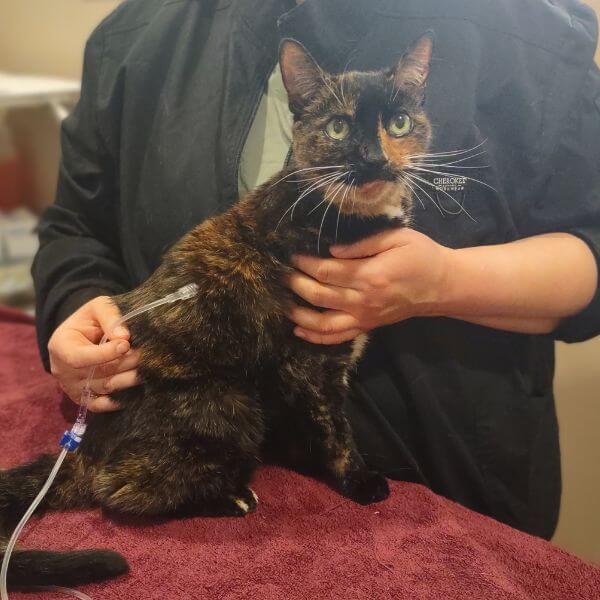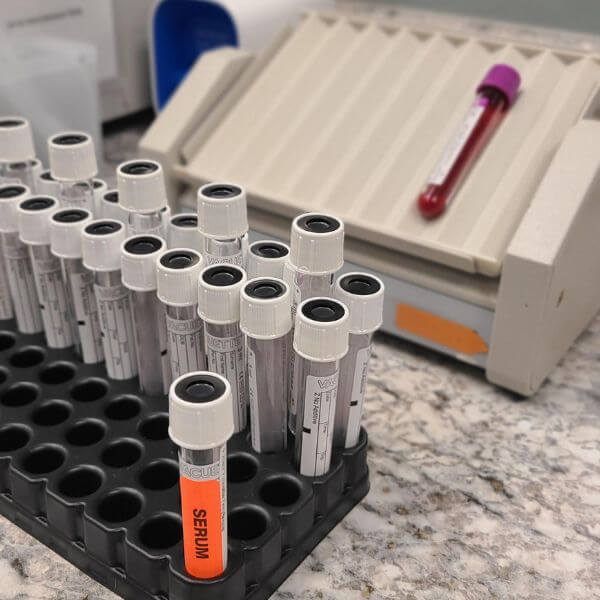A Guide For Pet Owners Learning About Kidney Disease In Cats And Dogs
When we think about vital organs in animals, the heart often comes to mind first. However, other organs - like the kidneys - are just as essential but don't always get the attention they deserve. The kidneys play a crucial role in filtering waste, balancing fluids and electrolytes, producing hormones for red blood cell production, and blood pressure regulation. But when the kidneys stop working properly, they lose their ability to filter blood and cannot keep up with their other duties leading to serious health issues for your pet – something no pet owner wants to think about.
Kidney disease can develop at any age but it is one of the most common diseases we diagnose in cats, especially as they get older. Detecting kidney dysfunction early with screening blood work and urinalysis provides an opportunity to make simple changes to slow the progression of eventual kidney failure.
What Do The Kidneys Do for Pets?
Think of the kidneys as the body's filtration system. During normal circulation, blood enters the kidneys and is filtered through microscopic holes in the blood vessels called fenestrations. Large components like red blood cells and proteins stay in the vessel, and smaller molecules like minerals, metabolic waste products, and water pass through those microscopic holes.
The kidneys reabsorb water and electrolytes as needed to prevent dehydration, while the remaining waste and excess water are excreted as urine. This filtering process is essential for detoxifying the body and maintaining a stable internal environment.

A "Tail" of Two Types of Dog and Cat Kidney Disease
Kidney disease can present in two manners in dogs and cats: acute kidney disease and chronic kidney disease (CKD). Acute kidney disease occurs suddenly and is usually caused by ingesting a toxic substance, an infection, or secondary to dehydration from another illness. Accidental ingestion of toxins such as those found in lilies (where even the pollen is toxic), grapes, or human medications like ibuprofen or acetaminophen can lead to profound kidney function loss. If this has happened to your pet, this is an emergency, and contacting your veterinarian or going straight to your closest 24-hour veterinary hospital is critical. In some cases prompt treatment stops progression to kidney failure.
Chronic kidney disease (CKD) is more common and (usually) slowly develops in older animals; we see this mostly in cats. In fact, according to research found from the American College of Veterinary Pathologists, it is the most common metabolic disease of domesticated cats, especially those over the age of 12. Chronic kidney disease in cats and dogs is sneaky because, by the time symptoms present themselves, irreversible damage is already done. That's why we return to routine blood work and urinalysis, which allow for early detection.
Early symptoms of kidney disease are often subtle and misunderstood. A common early sign is increased drinking and urination. Many owners are happy to see a cat drink more and think they are well hydrated. But this can be a sign that their kidneys cannot maintain the normal water balance, and since they are losing more water during filtration, they are clinically dehydrated, driving them to drink more water. Picky eating is also a common presentation but owners may think the patient's teeth are the cause. Although many senior pets have dental disease, a buildup of toxins in the body from kidney filter failure can create a foul odor and make them nauseous causing them to refuse their normal diet.
In advanced kidney disease, ulcers can form in the mouth, this is termed uremic stomatitis. It is important to note that periodontal disease can contribute to chronic kidney disease because of the continuous introduction of bacteria to the bloodstream from the mouth. This highlights why routine professional teeth cleanings are important to remove dental disease so the diagnosis of kidney disease can be clear.
Let the Diagnostics Speak for Themselves

The evaluation of routine blood work and urinalysis is essential for early detection kidney disease. Blood work monitors key markers like SDMA and BUN/creatinine, while urinalysis provides information regarding protein leakage from the kidneys and urine-specific gravity. Minor elevations and abnormal trending of these values often arise before symptoms show up, especially in chronic kidney disease.
Remember those microscopic holes that are only supposed to let minerals, metabolic waste products, and water through? When the kidney tissue becomes damaged, those filters are compromised and let things through that they shouldn't! The good thing is that if elevations are detected, we can start providing supportive care to help delay disease progression. As kidney disease becomes more advanced, additional values such as hematocrit and phosphorus are scrutinized to adjust treatment protocols.
The Stages of Dog and Cat Kidney Disease
The International Renal Interest Society (IRIS) has a set of parameters for veterinary practitioners to use to stage the severity of kidney disease for both acute and chronic disease states. The stages of chronic kidney disease are tailored for dogs and cats separately and reflect blood work and urinalysis values. Once a stage is determined, recommendations of monitoring timelines, medications, and other treatment options are determined out. These guidelines also direct when a patient moves from one stage to the next.
How Do You Manage Chronic Kidney Disease in Cats & Dogs?
While Chronic Kidney Disease can't be cured, effective management can slow its progression and improve your pet's quality of life. Key components of supportive care include fluid therapy, supplements, and diet adjustments.
Hydration is crucial for dogs but even more so for cats. Did you know: Cats, as a species, drink less water than dogs? Adding pet water fountains and multiple water bowls around the house can encourage kidney patients to drink more.
Subcutaneous fluid therapy is often recommended by a veterinarian when a patient cannot prevent dehydration with their own drinking habits. Depending on your pet's situation, subcutaneous fluid therapy can be done in the clinic or you can be trained to do it at home.
There are many supplements available to aid in kidney function but not all are equal with what they provide. We utilize Feline Renal Support and Canine Renal Support formulas by Standard Process. In more advanced stages of kidney disease, phosphorous binders and potassium supplements will become necessary. Prescription diets formulated to support kidney function are available through your veterinarian. These diets control the amount of protein and phosphorus which build up as the filtration process fails. Keeping your dog or cat eating through this disease management is crucial. Without eating, a pet will break down their own body tissue for energy. Please let your veterinarian know if they are not eating well as appetite stimulants and anti-nausea medications can be prescribed.
How Do These Kidney Disease Treatments Help My Pet?
Remember, when the kidneys are compromised, blood is not being filtered properly and metabolic waste products from the body will build up. Also key roles in production of red blood cells and blood pressure regulation are not fulfilled. Symptoms can include dehydration, nausea, loss of appetite, and weight loss.
The solution to the "pollution" of toxins in the blood? Dilution! That is where fluid therapy comes in. Extra fluid moving through the kidneys gives them an opportunity to remove more toxins, helping your pet feel better. The suggested supplements will help to promote kidney function and reduce symptoms through other avenues. For example, as kidney disease progresses, phosphorus doesn't get filtered out like it should. A phosphorus binder helps by binding the phosphorus from food so it cannot be absorbed in the first place. Don't forget that prescription kidney diets are lower in phosphorus and protein to help reduce the workload on the kidneys.
Kidneys Can Be Sensitive & Sneaky
As we've learned, the kidneys are vital organs but can suffer from both acute and chronic disease processes. They are a sensitive pair of organs that take part in regulating some of the most important aspects of a pet's physiology. Dogs and cats can succumb to acute injury from things that may not harm us, so knowledge is power and prompt assessment and treatment can interrupt the severity of damage.
Chronic kidney disease cannot be cured, only managed. The overall goal of management is to delay its progression and make sure your pet is comfortable as they live with this disease. While kidney disease is not always preventable, you can lower your pet's risk by making sure they drink plenty of water, have a high quality diet, and reduce the chance of exposure to toxic substances.
Remember, the kidneys are sneaky! Compromise can start before any visible symptoms. Routine exams and diagnostics done with your veterinarian are essential to tracking the health status as your pet ages. Early intervention can help to prolong their life. When kidney disease strikes, a strong working relationship with your vet will allow tailored healthcare decisions for your individual pet.
If you have questions and you'd like to reach out to us, you can call us directly at (218) 692-4400, or you can email us at [email protected]. Don't forget to follow us on social media Facebook, Instagram.

